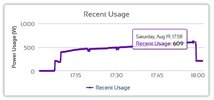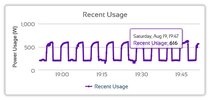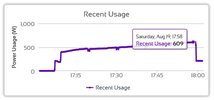- Joined
- 27 Jan 2008
- Messages
- 23,705
- Reaction score
- 2,670
- Location
- Llanfair Caereinion, Nr Welshpool
- Country

I swapped from a vented to heat pump dryer in the main to be able to close the window, and not drill a hole in the wall, the water running into same drain as washing machine is great, the old vented was set to just 1 Kw so was not fast, but put on a load at 17:10 and it finished at 21:30 that's 4 hours drying.
The dryer seems to use a mark/space ratio to heat and cool after the first hour, so starts but then
but then  at the end, the spacing varies
at the end, the spacing varies  so clearly some monitoring is going on and adjustment, with some very varied drying times. The overall use
so clearly some monitoring is going on and adjustment, with some very varied drying times. The overall use  shows around 400 watt average over 3.5 hours so it does seem to use less than the vented, and it was a rather full load, the main problem is if one splits the loads, one then forgets to put in the second load, and no two loads are the same, so near impossible to work out if worth splitting the load.
shows around 400 watt average over 3.5 hours so it does seem to use less than the vented, and it was a rather full load, the main problem is if one splits the loads, one then forgets to put in the second load, and no two loads are the same, so near impossible to work out if worth splitting the load.
The vented one had no sensor, so often put on a second time as cloths were not dry, but normally around 90 minutes to dry, so using around half the power for double the time, so no real saving. Using a dryer that used ambient air to cool the condenser was unlikely to work very well in the small utility room. May have worked in the kitchen, but food and laundry are not a good mix.
So question is do I need to change what I am doing? We use Ikea kallax boxes, for each colour, when box is full I wash, 33 x 38 x 33 cm (W x D x H) the washing machine says how much weight, but don't have handy scales in utility room, so have never weighed a load, maybe I should?
The dryer seems to use a mark/space ratio to heat and cool after the first hour, so starts
 but then
but then  at the end, the spacing varies
at the end, the spacing varies  so clearly some monitoring is going on and adjustment, with some very varied drying times. The overall use
so clearly some monitoring is going on and adjustment, with some very varied drying times. The overall use  shows around 400 watt average over 3.5 hours so it does seem to use less than the vented, and it was a rather full load, the main problem is if one splits the loads, one then forgets to put in the second load, and no two loads are the same, so near impossible to work out if worth splitting the load.
shows around 400 watt average over 3.5 hours so it does seem to use less than the vented, and it was a rather full load, the main problem is if one splits the loads, one then forgets to put in the second load, and no two loads are the same, so near impossible to work out if worth splitting the load.The vented one had no sensor, so often put on a second time as cloths were not dry, but normally around 90 minutes to dry, so using around half the power for double the time, so no real saving. Using a dryer that used ambient air to cool the condenser was unlikely to work very well in the small utility room. May have worked in the kitchen, but food and laundry are not a good mix.
So question is do I need to change what I am doing? We use Ikea kallax boxes, for each colour, when box is full I wash, 33 x 38 x 33 cm (W x D x H) the washing machine says how much weight, but don't have handy scales in utility room, so have never weighed a load, maybe I should?





